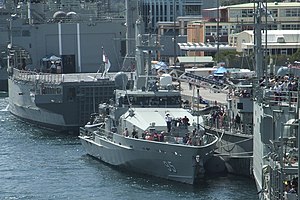| HMAS Maryborough (ACPB 95) | |
|---|---|
 HMAS Maryborough alongside at Fleet Base East for the September 2008 Navy Open Day | |
| Career (Australia) | |
| Namesake: | City of Maryborough, Queensland |
| Commissioned: | 8 December 2008 |
| Homeport: | HMAS Coonawarra, Darwin |
| Motto: | "Work In Unison" |
| Honours and awards: | Three inherited battle honours |
| Status: | Active as of 2013 |
| General characteristics | |
| Class & type: | Armidale class patrol boat |
| Displacement: | 270 tons |
| Length: | 56.8 m (186 ft) |
| Beam: | 9.5 m (31 ft) |
| Draught: | 2.7 m (8.9 ft) |
| Propulsion: | 2 x MTU 16V M70 2,320 kW diesels driving twin screws through ZF transmissions |
| Speed: | 25 knots (46 km/h; 29 mph) |
| Range: | 3,000 nautical miles (5,600 km; 3,500 mi) at 12 knots (22 km/h; 14 mph) |
| Boats & landing craft carried: | 2 x Zodiac 7.2 m (24 ft) RHIBs |
| Complement: | 21 |
| Sensors and processing systems: | Low light optical equipment, communication direction finding and radar |
| Armament: |
1 x Rafael Typhoon 25 mm naval stabilised deck gun 2 x 12.7 mm machine guns |
HMAS Maryborough (ACPB 95), named after the city of Maryborough, Queensland,[1] is one of fourteen Armidale class patrol boats operated by the Royal Australian Navy (RAN).
Design and construction[]
The Armidale class patrol boats are 56.8 metres (186 ft) long, with a beam of 9.5 metres (31 ft), a maximum draft of 2.25 metres (7.4 ft), and a displacement of 270 tons.[2][3] The semi-displacement vee hull is fabricated from aluminium alloy, and each vessel is built to a combination of Det Norske Veritas standards for high-speed light craft and RAN requirements.[3] The Armidales can travel at a maximum speed of 25 knots (46 km/h; 29 mph), and are driven by two propeller shafts, each connected to an MTU 16V M70 diesel.[2] The ships have a range of 3,000 nautical miles (5,600 km; 3,500 mi) at 12 knots (22 km/h; 14 mph), allowing them to patrol the waters around the distant territories of Australia, and are designed for standard patrols of 21 days, with a maximum endurance of 42 days.[2][3]
The main armament of the Armidale class is a Rafael Typhoon stabilised 25-millimetre (0.98 in) gun mount fitted with an M242 Bushmaster cannon.[2] Two 12.7-millimetre (0.50 in) machine guns are also carried.[4] Boarding operations are performed by two 7.2-metre (24 ft), waterjet propelled rigid-hulled inflatable boats (RHIBs).[3] Each RHIB is stored in a dedicated cradle and davit, and is capable of operating independently from the patrol boat as it carries its own communications, navigation, and safety equipment.[3][5]
Each patrol boat has a standard ship's company of 21 personnel, with a maximum of 29.[2][3] The Armidales do not have a permanently assigned ship's company; instead, they are assigned to divisions at a ratio of two vessels to three companies, which rotate through the vessels and allow the Armidales to spend more time at sea, without compromising sailors' rest time or training requirements.[3][6] A 20-berth auxiliary accommodation compartment was included in the design for the transportation of soldiers, illegal fishermen, or unauthorised arrivals; in the latter two cases, the compartment could be secured from the outside.[7] However, a malfunction in the sewerage treatment facilities aboard HMAS Maitland in August 2006 pumped hydrogen sulfide and carbon monoxide into the compartment, non-fatally poisoning four sailors working inside, after which use of the compartment for accommodation was banned across the class.[6][7]
Maryborough was one of two patrol boats ordered in 2005, following an 2004 federal election promise that the Coalition would provide a dedicated patrol force for the oil and gas producing facilities located off the north-west coast of Australia.[2][3][8] Maryborough was constructed by Austal at their shipyard in Henderson, Western Australia.[2] She was commissioned into the RAN in Brisbane on 8 December 2007.
Operational history[]
|
|
This section is empty. You can help by adding to it. |
Citations[]
- ↑ "Navy boat to be named HMAS Maryborough". ABC News. 7 December 2007. http://www.abc.net.au/news/stories/2007/12/07/2112221.htm.
- ↑ 2.0 2.1 2.2 2.3 2.4 2.5 2.6 Wertheim (ed.), The Naval Institute Guide to Combat Fleets of the World, p. 22
- ↑ 3.0 3.1 3.2 3.3 3.4 3.5 3.6 3.7 Kerr, Plain sailing
- ↑ Heron & Powell, in Australian Maritime Issues 2006, p. 132
- ↑ Heron & Powell, in Australian Maritime Issues 2006, p. 131
- ↑ 6.0 6.1 Kerr, Patrol boats shake down fuel faults
- ↑ 7.0 7.1 McKenna, Gas risk remains for navy boats
- ↑ Heron & Powell, in Australian Maritime Issues 2006, p. 130
References[]
- Books
- Heron, Wesley; Powell, Anthony (2007). "Welcome to the Armidale Class". In Forbes, Andrew and Lovi, Michelle. Australian Maritime Issues 2006. Papers in Australian Maritime Affairs. Sea Power Centre - Australia. pp. 129–134. ISBN 0-642-29644-8. ISSN 1327-5658. Archived from the original on 3 Oct 2009. http://web.archive.org/web/20091003233838/http://www.navy.gov.au/w/images/PIAMA19.pdf. Retrieved 12 May 2010.
- Wertheim, Eric, ed (2007). The Naval Institute Guide to Combat Fleets of the World: Their Ships, Aircraft, and Systems (15th ed.). Annapolis, MD: Naval Institute Press. ISBN 978-1-59114-955-2. OCLC 140283156. http://books.google.com/books?id=TJunjRvplU4C.
- Journal and news articles
- Kerr, Julian (1 January 2008). "Plain sailing: Australia's Armidales prove fit for task". Jane's Navy International. Jane's Information Group.
- Kerr, Julian (8 December 2007). "Patrol boats shake down fuel faults". The Australian: Defence Special Report. News Corporation. p. 8.
- McKenna, Michael (2 January 2010). "Gas risk remains for navy boats". The Australian. http://www.theaustralian.com.au/news/nation/gas-risk-remains-for-navy-boats/story-e6frg6nf-1225815368349. Retrieved 7 January 2010.
External links[]
The original article can be found at HMAS Maryborough (ACPB 95) and the edit history here.